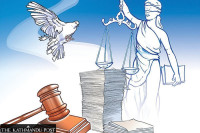National
Budget allocates large funds for debt servicing
Big borrowings for post-quake reconstruction, Covid response, and rupee’s devaluation blamed for high debt servicing costs.
Prithvi Man Shrestha
The government plans to pay 15 percent of its total projected revenue to domestic and foreign creditors in the next fiscal year 2022–23 with Rs186.6 billion allocated for repaying loans.
The government plans to earn Rs1.24 trillion in revenues in the next fiscal year.
Officials say the government liability is set to rise.
Many internal loans are maturing next fiscal year, interest to be paid is rising due to ongoing liquidity crunch and the liability to external creditors is also rising because of the depreciation of the Nepali rupee against the US dollar.
“When debt servicing exceeds five percent of the revenue, we have to be cautious,” said Nara Bahadur Thapa, former executive director of the Nepal Rastra Bank, who has an expertise in debt management.
He said that large debt servicing liability would reduce the government’s ability to finance other important sectors like education, health and development activities.
Even though the country’s debt liability was rising at a slow pace until fiscal year 2015–16, it surged with the country's large borrowings needed for the post-earthquake reconstruction.
According to the International Monetary Fund, Nepal witnessed a gradual decline in the debt to GDP ratio from 35 percent in the fiscal year 2011–12 to 25 percent in the fiscal year 2016–17 which is a sign of improving economic health. But after the country’s transition to fiscal federalism, Nepal’s public debt rose over the last several years with the ratio reaching 42.2 percent in the fiscal year 2019–20.
The substantial increase in debt in the fiscal year 2019–20 is driven by the impact of—and responses to—the Covid-19 pandemic, according to the IMF.
According to the Economic Survey 2021–22, the debt to GDP ratio of Nepal slightly came down to 38 percent as of mid-March.
Even from the perspective of the total size, public debt increased significantly with the outstanding debt reaching Rs1.72 trillion as of the second half of the current fiscal year, from Rs544.91 billion in the fiscal year 2014–15, according to the second quarterly report on public debt released by the Public Debt Management Office.
Along with the rise in debt, allocation to be made for debt servicing is also on the rise. Furthermore, the rising interest rates and devaluation of the rupee have also added to the burden, according to Hira Neupane, information officer at the Public Debt Management Office.
“In fact, we had to transfer the allocated budget from one heading to another to adjust the rising cost of debt servicing,” he said.
According to Neupane, the interest rate on treasury bills has reached as high as 8–9 percent from around 3–4 percent as the banking sector faces a liquidity crunch.
“A large chunk of development bonds are also maturing next fiscal year which has forced the government to increase budget allocation for debt servicing,” he said.
For example, the government has allocated Rs59.79 billion for principal repayment of development bonds maturing next fiscal year up from revised projected principal repayment of Rs17.1 billion, according to the Finance Ministry.
According to the Ministry, the government has allocated Rs54.14 billion alone for paying interest on loans for next fiscal year.
As much as Rs43.73 billion has been allocated for paying interest on domestic loans, while Rs10.41 billion has been allocated for paying interest on external loans.
Even Finance Minister Janardan Sharma acknowledged that the rising debt servicing costs have forced the government to increase the size of the recurrent budget for the next fiscal year.
Responding to the issues raised by lawmakers in parliament, Minister Sharma said, “Compared to the current fiscal year, more funds will be needed for principal repayment of internal loans in the next fiscal year. Internal debts are maturing next fiscal year and the government has to pay as high as Rs50 billion in principal repayment.”




 9.12°C Kathmandu
9.12°C Kathmandu















